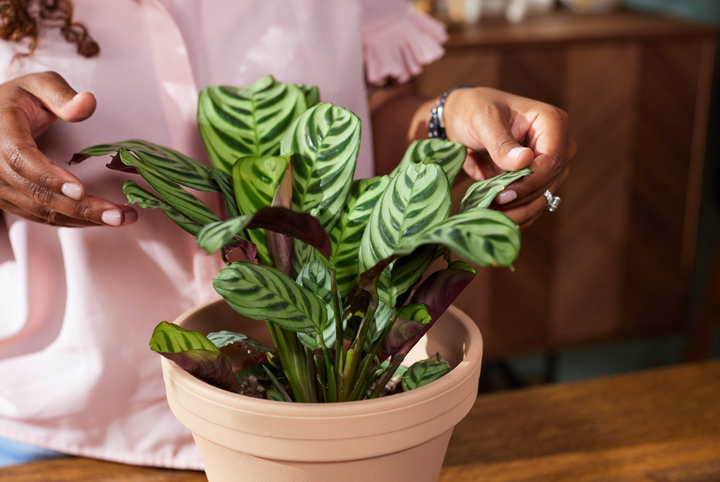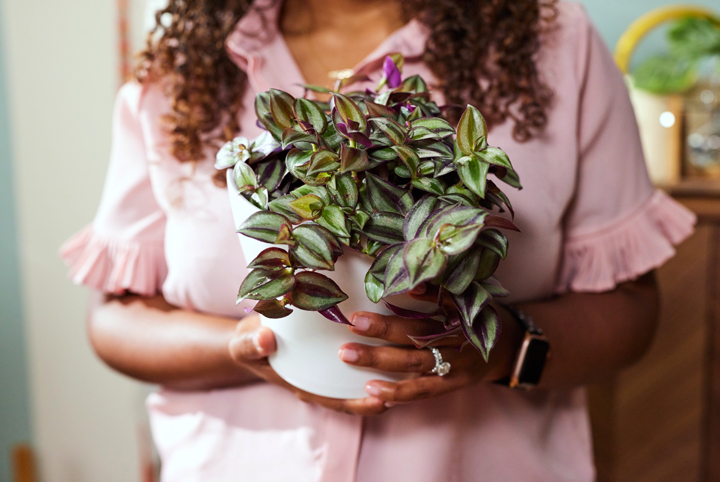
Some may think that plant care is a passive hobby – that you get your plant home, set it, and forget it. Although there are many super chill, easy-to-care-for plants, it’s always a good idea to keep an eye on your plants, tending to them as needed. Repotting, pruning and propagating your plants can be a fun and rewarding experience. When they grow and thrive, you’ll know it’s because of you! Here are some tips to get you started.
Related: The 15 Luckiest Plants for Your Home

Repotting
When you get your plant home, it’ll more than likely come in a plastic nursery pot. I know this isn’t necessarily the cutest plant pot, so you might be tempted to repot it right away. Actually, plants do really well in plastic nursery pots because they have tons of drainage holes! Drainage is important because you don’t want your plant’s roots sitting pooled in water, as this can lead to root rot.
I like to leave my plants in their nursery pots and put the whole nursery pot in a cute ceramic cache pot or basket.
As a rule of thumb, I only repot my plants if they’re rootbound. A plant is rootbound when it outgrows its current pot and the roots begin to wind round and round inside the pot. You’ll know a plant is rootbound if it’s been in its pot a while, and you can see roots peeking out of the top of the soil.
Related: 15 Houseplants That Can Help Reduce Humidity In A Bathroom
If you’re repotting a plant, choose a new pot with drainage to avoid water sitting around the plant’s roots. Opt for a pot that’s no more than two inches larger in diameter than the plant’s original pot. (Any larger and the soil may take too long to dry between waterings or risk shocking more sensitive plants.)

Pruning
Pruning is like a haircut for your plants! It helps to keep your plant babies healthy, can maintain a specific shape, and help keep your beloved plants from taking over your space (although a plant-filled space like this one can certainly make for a cozy home!). I also love that pruning can encourage new growth; the plant puts out new branches or leaves to compensate for what’s been pruned.
You can prune your plants with shears, scissors, or a knife, as long as your tool of choice is sharp. Use some rubbing alcohol to sterilize them so as not to introduce any bacteria to your plants.

When it comes time to prune your plants, remember, less is more – you can always cut more off, but you can’t re-attach cuttings if you over-prune. I like to hold the branch or leaves I’m planning to cut and imagine how the plant will look without them before making the cut.
If I’m planning to use the cuttings I took for propagation, I make sure to cut on about a 45 degree angle and clip the cutting into segments, including one node or aerial root per leaf.
Related: Our Resident Plant Mom Reveals 5 Plants That’ll Improve Your Mental Health
Propagation
So what is propagation? Propagation is a fancy word for creating a new plant from an existing plant. Propagation is huge in the plant community because it’s a fun and cost effective way to turn your home or yard into your own personal oasis or to grow new plants to share with your friends.

There are three different propagation methods: water propagation, soil propagation, and propagation by division. Water propagation refers to putting cuttings in water to root. Soil propagation means putting cuttings directly in damp soil to allow them to root. Finally, propagation by division refers to splitting a mother plant in two and planting it in two separate pots.
This raises the question: how do you know which method of propagation you should use? I personally like water propagation because I’ve found it works for most of the plants I want to propagate. Plus, I love watching the roots develop when I stick my cuttings in a clear jar or glass of water. Overall, some plants do better when propagated in soil or divided. If in doubt, look up the plant you want to propagate in your favourite search engine and do a little research into the best propagation methods.
Related: How to Propagate Your Plants – Our Resident Plant Mama Reveals Her Top Tips!

Here are a few general tips for each propagation method:
- For water propagation, keep the leaves out of the water or they can rot. If there isn’t enough of a stem on your cuttings to do this, you can pluck the lower leaves off.
- For soil propagation, keep the soil moist to create the optimal environment for roots to form.
- And finally, for propagation by division, take your time and be gentle to minimize damage to the plant’s roots.
For more easy plant care tips, check out Amanda’s video below:
Images courtesy of HGTV Canada
HGTV your inbox.
By clicking "SIGN UP” you agree to receive emails from HGTV and accept Corus' Terms of Use and Corus' Privacy Policy.



